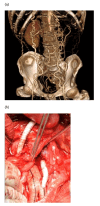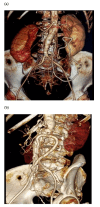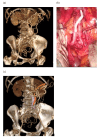Open revascularization for chronic mesenteric ischemia in the endovascular era: a quaternary-center experience and management algorithm
- PMID: 38433982
- PMCID: PMC10903786
- DOI: 10.1590/1677-5449.202301482
Open revascularization for chronic mesenteric ischemia in the endovascular era: a quaternary-center experience and management algorithm
Abstract
Background: Chronic mesenteric ischemia (CMI) is a debilitating disease with a heavy burden on quality of life. Stenting of the superior mesenteric artery (SMA) is the first option for treatment, but there is a lack of consensus defining precise indications for open revascularization (OR).
Objectives: To describe a series of 4 patients with CMI treated with OR and to present an algorithm for the management of this condition.
Methods: Three patients presented with typical intestinal angina and weight loss. One patient was subjected to prophylactic revascularization during open abdominal aortic aneurysm repair. Surgical techniques included: 1) Bypass from the infrarenal aorta to the SMA; 2) Bypass from an aorto-bifemoral polyester graft to the SMA; 3) Bypass from the right iliac artery to the SMA; 4) Bypass from the right graft limb of an aorto-biiliac polyester graft to the median colic artery at Riolan's arcade. PTFE was used in all surgeries. All grafts were placed in a retrograde configuration, tunneled under the left renal vein, making a smooth C-loop. A treatment algorithm was constructed based on the institution's experience and a review of recent literature.
Results: All patients demonstrated resolution of symptoms and recovery of body weight. All grafts are patent after mean follow-up of two years.
Conclusions: Open revascularization using the C-loop configuration is a valuable technique for CMI and may be considered in selected cases. The algorithm constructed may help decision planning in other quaternary centers.
Contexto: A isquemia mesentérica crônica (IMC) é uma doença debilitante, com grave impacto na qualidade de vida. A literatura recomenda a angioplastia com stent da artéria mesentérica superior (AMS) como primeira opção de tratamento, mas há falta de consenso que defina indicações precisas para a revascularização aberta.
Objetivos: Descrever uma série de quatro pacientes com IMC, tratados com revascularização aberta, e apresentar um algoritmo para o manejo dessa condição.
Métodos: Três pacientes apresentaram angina intestinal típica e perda ponderal. Uma paciente foi submetida a reparo aberto de aneurisma da aorta abdominal e apresentava obstrução da AMS, que foi revascularizada profilaticamente. As técnicas cirúrgicas incluíram: 1) enxerto entre a aorta infrarrenal e a AMS; 2) enxerto entre o dácron utilizado em um enxerto aortobifemoral e a AMS; 3) enxerto entre a artéria ilíaca comum direita e a AMS; e 4) enxerto entre o ramo direito do dácron utilizado em um enxerto aorto-biilíaco e a artéria cólica média (ao nível da arcada de Riolan). Todos os enxertos foram feitos utilizando politetrafluoretileno em uma configuração retrógrada, tunelizados abaixo da veia renal esquerda, fazendo uma alça em C.
Resultados: Todos os pacientes demonstraram resolução dos sintomas e ganho ponderal. Todos os enxertos se mantiveram pérvios durante um seguimento médio de 2 anos.
Conclusões: A revascularização aberta para IMC utilizando-se a alça em C é uma técnica valiosa e pode ser considerada em pacientes selecionados. O algoritmo proposto pode auxiliar na decisão terapêutica em centros quaternários.
Keywords: blood vessel prosthesis; mesenteric arteries; mesenteric ischemia; mesenteric vascular occlusion; superior mesenteric artery.
Copyright© 2024 The authors.
Conflict of interest statement
Conflicts of interest: No conflicts of interest declared concerning the publication of this article.
Figures




Similar articles
-
Fenestrated endovascular grafts for the repair of juxtarenal aortic aneurysms: an evidence-based analysis.Ont Health Technol Assess Ser. 2009;9(4):1-51. Epub 2009 Jul 1. Ont Health Technol Assess Ser. 2009. PMID: 23074534 Free PMC article.
-
Direct Retrograde Bypass is Preferable to Antegrade Bypass for Open Mesenteric Revascularization.Ann Vasc Surg. 2020 Jul;66:263-271. doi: 10.1016/j.avsg.2020.01.019. Epub 2020 Jan 10. Ann Vasc Surg. 2020. PMID: 31931133
-
The Vascular Patient - Chronic Mesenteric Ischemia, AAA and Iliac Occlusion.Port J Card Thorac Vasc Surg. 2023 Apr 4;30(1):65-68. doi: 10.48729/pjctvs.235. Port J Card Thorac Vasc Surg. 2023. PMID: 37029949
-
Acute mesenteric ischemia as late complication of previous endovascular treatment in young woman. Case report and review of the literature.Ann Ital Chir. 2021 Jun 21;10:S2239253X21033119. Ann Ital Chir. 2021. PMID: 34668486 Review.
-
Ascending Aorta to Hepatic and Mesenteric Artery Bypassing, in Patients with Chronic Mesenteric Ischemia and Extensive Aortic Disease-A Case Report and Review of the Literature.Ann Vasc Surg. 2017 Feb;39:292.e9-292.e15. doi: 10.1016/j.avsg.2016.08.036. Epub 2016 Nov 28. Ann Vasc Surg. 2017. PMID: 27908818 Review.
References
-
- Menezes FH. In: Protocolos e condutas em terapia intensiva. Dragosavac D, Araújo S, editors. São Paulo: Atheneu; 2014. Angina abdominal e trombose mesentérica. pp. 571–579.
LinkOut - more resources
Full Text Sources
